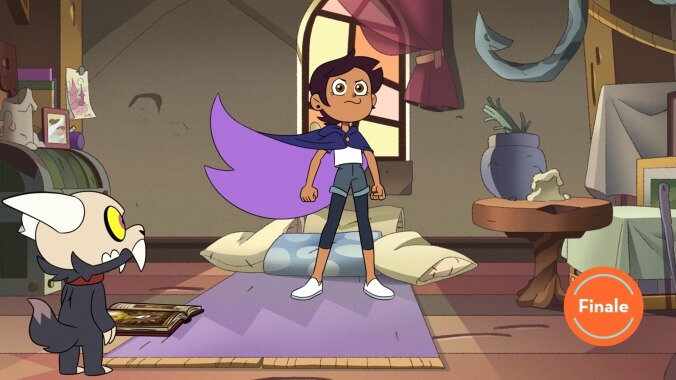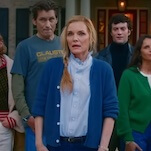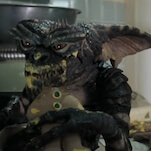There are two different shows that are somewhat working against each other in The Owl House. There’s the show about a powerful, exiled, cursed witch who’s being hunted by her sister and the “State,” the magic-controlling government whose leader wants to use her for something nefarious. And there’s the show about an insecure, supposedly-weird girl who, through the power of her over-wrought, stubborn determination, is able to alter the student dynamics and strict rules and decorum of a magic school beholden to that government’s ideals. The narratives here merge only in fits and starts, mostly concerning that stratified coven system, which for eighteen episodes felt too vague and ill-defined to really seem like it mattered; after all, after some human randomly appeared and did some stuff, she somehow fast-tracked herself into a multidisciplinary magic track that didn’t even exist, disrupting what seemed to be ages of Boiling Isles tradition. It happens so fast, with such little pushback. What even is this whole world all about? King has to narrate the entire backstory of the Boiling Isles at the beginning of “Young Blood, Old Souls,” to fill us in, which feels like it comes way too late in the season and which really raises more questions than it answers. It also inadvertently exposes the overall flaws of a show that, at least, presents an enjoyable, tense, and intriguing finale.
With all due respect on the Luz/Amity ‘ship (which I’ll get to in the Stray Observations), “Young Blood, Old Souls” focuses on the by far the most important storyline of the show: Eda’s curse and her rocky, wavering relationship with her sister. The backstory revealed here is a little clunky–Lilith says Eda “worked twice as hard” as her to get into Hexside, but we don’t really see that in the flashback, we don’t really get a sense of how Eda feels about the school itself and the strict coven system forcing this contest between her and her sister, and what does it say about a public that sees a kid transform into a creature, only to throw rocks at her?–but the core notion here, the shared familial, conflicting love between Eda and Lilith, is strong. It’s fine to accept that the current state of affairs are derived from this incident, such as Eda’s utter distrust and hate for the entire coven system, but without a visual or narrative beat that shows that Eda truly blames the “system” for her estranged sister and her curse, it just feels speculative and opaque.
It also brings to light Lilith’s dedication to the coven and the Emperor. It was never so much that she believed in that system but that she thought Belos could save Eda and ostensibly fix her mistake of cursing Eda in the first place. Belos had no intention of doing such a thing, and I sort of dig his bold faced lie in service his supposed grand commitment to his belief of disposing wild witches at the command of this “Titan.” But at the end, she utilizes the sharing-pain spell on her sister that she once used when they were younger. How well-known is this spell? How would she even know it would have worked in the way that it did, on something so complicated, and so dang well? Something just feels off, or incomplete. I know it’s silly to try and find logic in magic. But I’m not trying to find logic. I’m trying to find consistency, something to hang my hat on when it comes to who wields what powers, who has access to acquiring/learning such powers, and the degree of their effectiveness.
That especially is applied to Luz. For a human with little experience with magic, and who has to use a lot of post-its with runes on them to cast her spells, she’s… bizarrely effective with it. She takes out a whole set of castle guards and even holds her own for a bit when facing Lilith and Emperor Belos. But I couldn’t help but ask myself: how is she carrying all these pieces of paper? How is she casting them so fast? There’s a clever, defiant moment where she “detonates” the runes on the doorway to her home world when she hands it over to Belos (the exchanged looks between them is excellent) but I don’t quite remember if she learned how to wield Owlbert like that. All this comes across like nit-picking, but the extent to which shows like Steven Universe and Gravity Falls really put in the work to make details cohere so that the overall world and premise stand out. The Owl House just feels shaky and broad, solely interested in its premise to tell “just fine” stories of its characters, to set up “just fine” conflicts and mysteries, and to explore the “just fine” ‘ship of Luz and Amity*.
I don’t mean to be all “stonewalled” of the show’s efforts. The animation and art direction continues to be stellar. From the genuinely disturbing image of the beating heart above Belos’ throne, to the off-putting. three-headed statue that is called forth to perform Eda’s petrification, the episode (and the show as a whole) really can bring some visceral power within the frame. The battle between Belos and Luz was visually tense and well-done, and last episode’s bridge battle between Eda and Lilith was fantastic, really drawing out the power of its two witches and their history into one single, specific fight. Even if the way that sibling was developed seem wobbly, and even if the show felt like they pushed that relationship way too far into the background, it always stood out in every encounter, both mundane and wild. And while the show struggles to really structure and ground a lot of the various relationships, the connection that Eda and Luz have really comes through in that moment before she’s sent up to be petrified. Also, early in the episode, King admits, in a surprising moment of honesty, how much Eda means to him too. It’s a cliche as old as time, but The Owl House really makes the “crusty old person with a heart of gold” concept really work.
Now with Eda and Lilith in the same boat. With depleted powers and one grey eye each, they, Luz, and King are now essentially on the same level, up against a powerful force working on something deeply sinister (it looks like the door to the human world, but there’s a lot more construction occurring around it). It’s a little silly to think that Luz could legitimately re-teach Eda magic, partly because Luz still needs something physical to draw runes on, and partly because, as the show established, the inhabitants of the Boiling Isles function off of magically differently. Still, “Young Blood, Old Souls” is about the makeshift power of non-traditional families, a theme that only came through on occasion throughout this show. It’s unclear how this theme will butt up against the video Luz makes for her mother for some reason (will she even be able to go back home now that the door is destroyed?), but maybe its second season will conjure up the magic to finally make this all come together.
Stray observations
- Willow and Gus don’t do anything. Instigating the public’s chant about letting Eda go led to… nothing. There’s not really a public refutation against the Emperor, or the coven system, or anything like that. Heck, at the end, the Emperor comes out, gives a speech about wild witches, and everything seems back to normal. I guess you can interpret it as how crowds tend to be deeply fickle an easily swayed, but it feels like a stretch to think that’s what the The Owl House is going for here.
- I wish was I was more engaged in the Luz/Amity relationship than I actually am. It’s deeply important and meaningful to the progress of LGTBQ+ portrayals on television, particularly for young kids, but I find its narrative development a bit hollow. I’m not really a fan of Amity of in general–I found her change from genuine bully to easily embarrassed nerd way too expedient and convenient, to the point that the introduction of another bully character only ended up re-enforcing how awkward it is. (I also think that there’s a bad habit of cartoons recently really putting too much emphasis on ‘ship-cultivating than character development–see She-Ra, Star Vs. The Forces of Evil, Voltron–but that’s a discussion for another day.)
- At the very least, I’m intrigued over what Belos wants with the doorway to the human world. He claims to speak for the Titan (itself a mysterious-as-heck concept, since the Boiling Isle is literally the bones of a Titan), who itself claims doesn’t want to invade the human world. If all of this is true, then what would this Titan really want the door for? (Guess: the power overall to open the door to other alternate universes.) If it’s all false, then what is Belos really working on? (Guess: probably the same, but more specifically to consolidate power.) Any thoughts in the comments?
- Unless the show explodes in popularity and readership, this may be the last review we do for it. For all my issues I do still think this show is brimming with potential, and hopefully it’ll match that potential in season two! Thanks for reading.








































